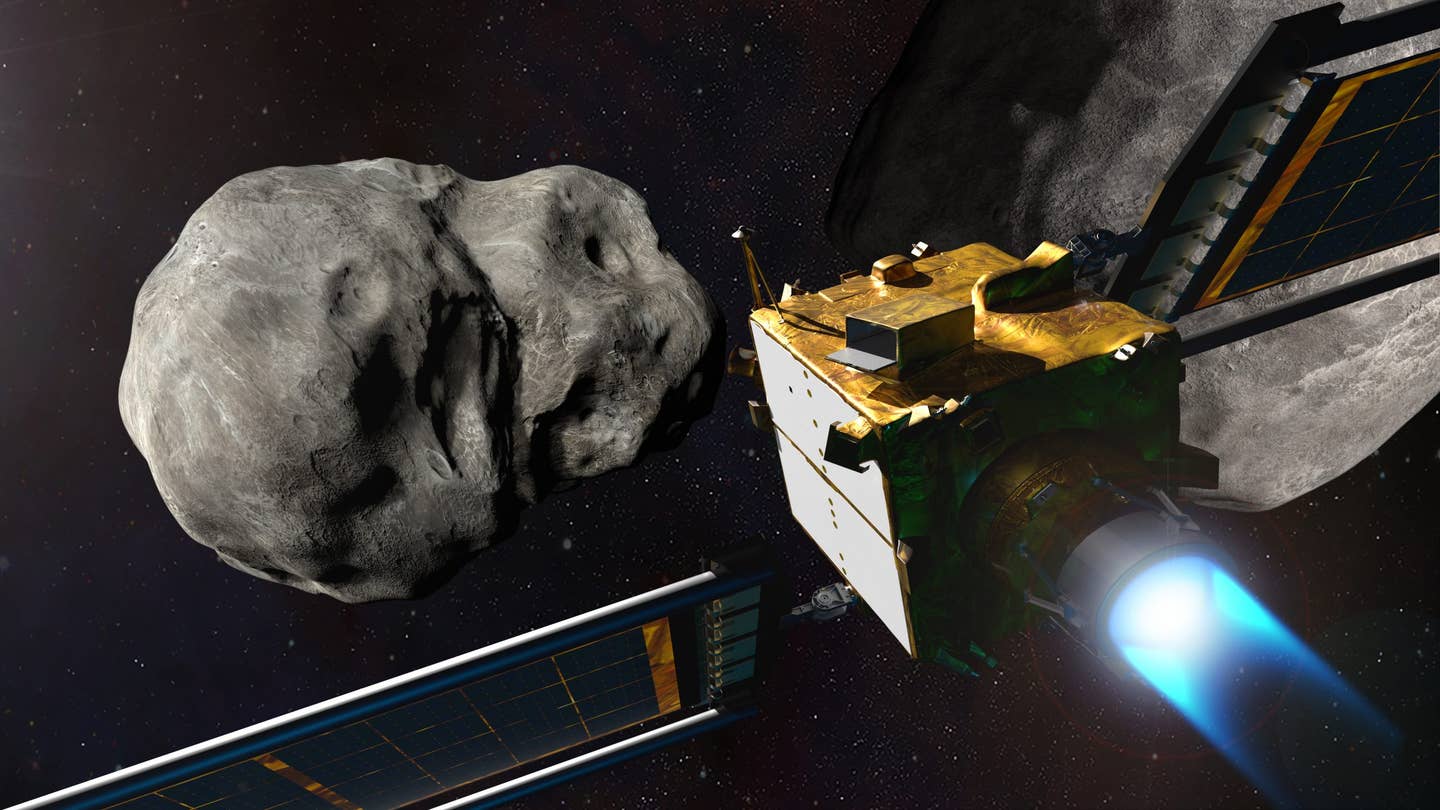5 Things to Know About This Week’s Asteroid Mission
NASA is hurling a spacecraft at a passing asteroid to try and change its course.

Illustration of NASA’s DART spacecraft and the Italian Space Agency’s (ASI) LICIACube prior to impact at the Didymos binary system. Credit: NASA/Johns Hopkins APL/Steve Gribben
NASA’s DART mission launch window opens early Wednesday morning, hoping to collide with an asteroid as it passes Earth. Here are five things you need to know about this historic operation:
1. The Plan
While it may seem like an absurd idea, NASA is planning to crash a spacecraft into an asteroid as it passes Earth. The DART spacecraft itself is 100 times smaller than its intended target, but will make its impact at approximately 6.6 km/s, or nearly 15,000 mph.
The Johns Hopkins Applied Physics Laboratory (APL) estimates that the impact will change the trajectory of the asteroid by less than one percent—which is just enough to make a substantial change later in its course. Shortly before the payload, DRACO, makes impact, it will release a smaller CubeSat, the LICIACube, that will record images of DRACO’s approach and ultimate demise.
The entire trip will last about 10 months for the DART mission, giving NASA ample opportunity to test out some new technologies.
2. What DART Stands For
The Double Asteroid Redirection Test, or DART for short, is NASA’s mission led by the APL. The “double” refers to the type of asteroid DRACO will be crashing into. The asteroid, dubbed “Dimorphos” orbited by a slightly smaller asteroid, “Didymos.”
The two make up what’s known as a double asteroid system. Didymos, the larger of the two, is nearly half a mile in diameter. Its smaller, asteroid moonlet, Dimorphos, has a diameter of only 160 meters. NASA is targeting the latter head-on, therefore changing its orbit around Didymos and slightly changing the binary asteroid system’s trajectory.
3. New Technology Will Be Used
The DART spacecraft is technically the second of its kind, following the 2005 Deep Impact mission, where NASA successfully landed an impactor spacecraft on a passing comet. However, DART will be the first to intentionally collide with an asteroid to change its course.
This mission will also be the debut of the Small-body Maneuvering Autonomous Real Time Navigation (SMART) system. This will work as part of the guidance, navigation, and control (GNC) system to distinguish between the two asteroids and maneuver toward Dimorphos. The system will activate approximately one hour before impact.
According to APL, the DART team is “leveraging decades of missile guidance algorithms developed at APL.”
The DART mission serves as an opportunity to test its new ion propulsion system, NASA’s Evolutionary Xenon Thruster-Commercial (NEXT-C). The propulsion system is electric, powered by solar energy, and uses a gridded ion engine to produce thrust with a xenon propellant.
Much like the International Space Station, DART will be using a Roll-Out Solar Array (ROSA) to power its systems. Each wing, extending 8.6 meters in length, will partially house a “transformational solar array” that includes reflective concentrators that produce three times more power than current standards.
4. How This Can Protect Earth from Interplanetary Harm
Like something out of a sci-fi movie, NASA established the Planetary Defense Coordination Office (PDCO) in 2016.
Since there aren’t any aliens nearby to worry about, the PDCO focuses on the early detection of potentially hazardous objects (PHOs), things that could pose a threat if they come too close to our planet. The PDCO takes the lead with the U.S. government when it comes to an actual impact threat.
DART will serve as the PDCO’s first mission and is only one part of NASA’s larger planetary defense strategy. DART falls within the mitigation portion of the strategy, alongside certain FEMA exercises.
5. How The Launch Will Work
As part of ongoing collaboration between NASA and SpaceX, the DART spacecraft will be taking off on a Falcon 9 rocket from Vandenberg Space Force Base in California. The launch window opens on Wednesday, November 24, at 1:12 a.m. EST.
While the spacecraft may be leaving Earth this week, it will take almost a year for DART to reach its destination. According to APL, DART is estimated to collide with Dimorphos between September 26 and October 1 of next year.
Coverage of the launch will begin on Wednesday at 12:30 a.m. on NASA’s website.

Sign-up for newsletters & special offers!
Get the latest FLYING stories & special offers delivered directly to your inbox






